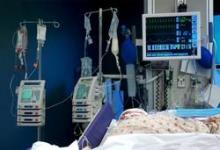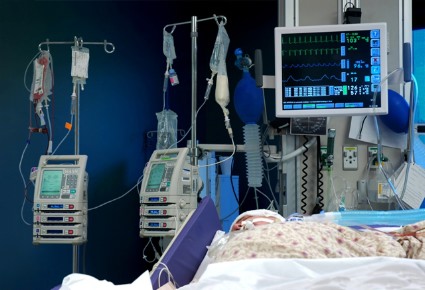User login
Patients discharged from intensive care units were far more likely to report physical symptoms of depression than posttraumatic distress disorder symptoms, based on research published online April 6 in Lancet Respiratory Medicine.
"Depression and posttraumatic distress disorder are important mental health problems after critical illness, but our findings show that depression is at least five times more common than posttraumatic distress disorder and is largely somatic in nature," said James C. Jackson, Psy.D., at Vanderbilt University in Nashville, Tenn., and his associates. "This finding suggests that physical disability contributes predominantly to this depression, which has implications for the roles of physical rehabilitation vs. antidepressant medications in the prevention and management of depression after ICU admission." Lancet
Respir. Med. 2014 March 6 [doi: 10.1016/S2213-2600(14)70051-7]
The prospective, multicenter longitudinal cohort study enrolled 821 patients (median age, 61 years) treated in medical and surgical ICUs for respiratory failure, cardiogenic shock, or septic shock.
Data were available for 406 patients 3 months after discharge, of which 37% reported at least mild depression symptoms, while only 7% reported posttraumatic stress disorder (PTSD) symptoms. At 12 months after discharge, 33% of patients reported depression, compared with 7% for PTSD. Depression was primarily somatic in nature and was common even among patients with no past history of the disorder (prevalence, 30% and 29% at 3 and 12 months, respectively). Disabilities in activities of daily living affected from 23%-32% of patients.
"Our data further show that monitoring these outcomes is relevant for survivors of all ages, and that non–pharmacological interventions during the ICU stay (previously assumed to improve physical outcomes in ICU survivors) should be tested in terms of their ability to change mental health and functional outcomes," the investigators concluded.
Dr. Jackson receives grant support from the National Institutes of Health. Ten of his associates reported receiving funding, honoraria, and other support from Hospira; Abbott; Orion Pharma; the Veterans Affairs Clinical Science Research and Development Service; the Tennessee Valley Geriatric Research, Education, and Clinical Center; the National Institutes of Health; and the Vanderbilt Clinical and Translational Research Scholars Program.
Just 15 years ago, the long-term sequelae of severe sepsis and acute respiratory distress syndrome were unknown, said Dr. Hallie C. Prescott and Dr. Theodore J. Iwashyna. But as survival rates in intensive care units improved, "it became clear that something was not right. Survivors were not the same after critical illness. Rather, they had new weaknesses, cognitive impairment, depression, and early death."
But the causes and treatment of post–intensive care syndrome have eluded researchers, said Dr. Prescott and Dr. Iwashyna. The current study’s findings help fill that gap. "By differentiation of depression into cognitive and physical components, Jackson and colleagues have provided an important step towards tailoring of future interventions to specific symptoms subsets, and not the generic diagnosis of depression."
Somatic symptoms among survivors might be from functional limitations and medical comorbidities instead of a neurochemical imbalance, they added. "As such, traditional pharmacologic therapies for depression might be less likely to provide significant benefit alone (or at all). Instead, doctors might need to address the many diagnoses that contribute to poor sleep, impaired concentration, weakness, and fatigue. Although largely absent from the history of post–intensive care syndrome to date, consideration is needed of how common chronic medical conditions such as diabetes, heart failure, and chronic pulmonary disease contribute to the morbidity of survivors of critical illness."
Dr. Prescott is a clinical fellow and Dr. Iwashyna is an assistant professor of internal medicine with the University of Michigan, Ann Arbor. They reported receiving grant support from the National Institutes of Health and the Department of Veterans Affairs. These remarks were taken from their editorial accompanying Dr. Jackson’s report (Lancet 2014 [doi:10.1016/S2213-2600(14)70071-2]).
Just 15 years ago, the long-term sequelae of severe sepsis and acute respiratory distress syndrome were unknown, said Dr. Hallie C. Prescott and Dr. Theodore J. Iwashyna. But as survival rates in intensive care units improved, "it became clear that something was not right. Survivors were not the same after critical illness. Rather, they had new weaknesses, cognitive impairment, depression, and early death."
But the causes and treatment of post–intensive care syndrome have eluded researchers, said Dr. Prescott and Dr. Iwashyna. The current study’s findings help fill that gap. "By differentiation of depression into cognitive and physical components, Jackson and colleagues have provided an important step towards tailoring of future interventions to specific symptoms subsets, and not the generic diagnosis of depression."
Somatic symptoms among survivors might be from functional limitations and medical comorbidities instead of a neurochemical imbalance, they added. "As such, traditional pharmacologic therapies for depression might be less likely to provide significant benefit alone (or at all). Instead, doctors might need to address the many diagnoses that contribute to poor sleep, impaired concentration, weakness, and fatigue. Although largely absent from the history of post–intensive care syndrome to date, consideration is needed of how common chronic medical conditions such as diabetes, heart failure, and chronic pulmonary disease contribute to the morbidity of survivors of critical illness."
Dr. Prescott is a clinical fellow and Dr. Iwashyna is an assistant professor of internal medicine with the University of Michigan, Ann Arbor. They reported receiving grant support from the National Institutes of Health and the Department of Veterans Affairs. These remarks were taken from their editorial accompanying Dr. Jackson’s report (Lancet 2014 [doi:10.1016/S2213-2600(14)70071-2]).
Just 15 years ago, the long-term sequelae of severe sepsis and acute respiratory distress syndrome were unknown, said Dr. Hallie C. Prescott and Dr. Theodore J. Iwashyna. But as survival rates in intensive care units improved, "it became clear that something was not right. Survivors were not the same after critical illness. Rather, they had new weaknesses, cognitive impairment, depression, and early death."
But the causes and treatment of post–intensive care syndrome have eluded researchers, said Dr. Prescott and Dr. Iwashyna. The current study’s findings help fill that gap. "By differentiation of depression into cognitive and physical components, Jackson and colleagues have provided an important step towards tailoring of future interventions to specific symptoms subsets, and not the generic diagnosis of depression."
Somatic symptoms among survivors might be from functional limitations and medical comorbidities instead of a neurochemical imbalance, they added. "As such, traditional pharmacologic therapies for depression might be less likely to provide significant benefit alone (or at all). Instead, doctors might need to address the many diagnoses that contribute to poor sleep, impaired concentration, weakness, and fatigue. Although largely absent from the history of post–intensive care syndrome to date, consideration is needed of how common chronic medical conditions such as diabetes, heart failure, and chronic pulmonary disease contribute to the morbidity of survivors of critical illness."
Dr. Prescott is a clinical fellow and Dr. Iwashyna is an assistant professor of internal medicine with the University of Michigan, Ann Arbor. They reported receiving grant support from the National Institutes of Health and the Department of Veterans Affairs. These remarks were taken from their editorial accompanying Dr. Jackson’s report (Lancet 2014 [doi:10.1016/S2213-2600(14)70071-2]).
Patients discharged from intensive care units were far more likely to report physical symptoms of depression than posttraumatic distress disorder symptoms, based on research published online April 6 in Lancet Respiratory Medicine.
"Depression and posttraumatic distress disorder are important mental health problems after critical illness, but our findings show that depression is at least five times more common than posttraumatic distress disorder and is largely somatic in nature," said James C. Jackson, Psy.D., at Vanderbilt University in Nashville, Tenn., and his associates. "This finding suggests that physical disability contributes predominantly to this depression, which has implications for the roles of physical rehabilitation vs. antidepressant medications in the prevention and management of depression after ICU admission." Lancet
Respir. Med. 2014 March 6 [doi: 10.1016/S2213-2600(14)70051-7]
The prospective, multicenter longitudinal cohort study enrolled 821 patients (median age, 61 years) treated in medical and surgical ICUs for respiratory failure, cardiogenic shock, or septic shock.
Data were available for 406 patients 3 months after discharge, of which 37% reported at least mild depression symptoms, while only 7% reported posttraumatic stress disorder (PTSD) symptoms. At 12 months after discharge, 33% of patients reported depression, compared with 7% for PTSD. Depression was primarily somatic in nature and was common even among patients with no past history of the disorder (prevalence, 30% and 29% at 3 and 12 months, respectively). Disabilities in activities of daily living affected from 23%-32% of patients.
"Our data further show that monitoring these outcomes is relevant for survivors of all ages, and that non–pharmacological interventions during the ICU stay (previously assumed to improve physical outcomes in ICU survivors) should be tested in terms of their ability to change mental health and functional outcomes," the investigators concluded.
Dr. Jackson receives grant support from the National Institutes of Health. Ten of his associates reported receiving funding, honoraria, and other support from Hospira; Abbott; Orion Pharma; the Veterans Affairs Clinical Science Research and Development Service; the Tennessee Valley Geriatric Research, Education, and Clinical Center; the National Institutes of Health; and the Vanderbilt Clinical and Translational Research Scholars Program.
Patients discharged from intensive care units were far more likely to report physical symptoms of depression than posttraumatic distress disorder symptoms, based on research published online April 6 in Lancet Respiratory Medicine.
"Depression and posttraumatic distress disorder are important mental health problems after critical illness, but our findings show that depression is at least five times more common than posttraumatic distress disorder and is largely somatic in nature," said James C. Jackson, Psy.D., at Vanderbilt University in Nashville, Tenn., and his associates. "This finding suggests that physical disability contributes predominantly to this depression, which has implications for the roles of physical rehabilitation vs. antidepressant medications in the prevention and management of depression after ICU admission." Lancet
Respir. Med. 2014 March 6 [doi: 10.1016/S2213-2600(14)70051-7]
The prospective, multicenter longitudinal cohort study enrolled 821 patients (median age, 61 years) treated in medical and surgical ICUs for respiratory failure, cardiogenic shock, or septic shock.
Data were available for 406 patients 3 months after discharge, of which 37% reported at least mild depression symptoms, while only 7% reported posttraumatic stress disorder (PTSD) symptoms. At 12 months after discharge, 33% of patients reported depression, compared with 7% for PTSD. Depression was primarily somatic in nature and was common even among patients with no past history of the disorder (prevalence, 30% and 29% at 3 and 12 months, respectively). Disabilities in activities of daily living affected from 23%-32% of patients.
"Our data further show that monitoring these outcomes is relevant for survivors of all ages, and that non–pharmacological interventions during the ICU stay (previously assumed to improve physical outcomes in ICU survivors) should be tested in terms of their ability to change mental health and functional outcomes," the investigators concluded.
Dr. Jackson receives grant support from the National Institutes of Health. Ten of his associates reported receiving funding, honoraria, and other support from Hospira; Abbott; Orion Pharma; the Veterans Affairs Clinical Science Research and Development Service; the Tennessee Valley Geriatric Research, Education, and Clinical Center; the National Institutes of Health; and the Vanderbilt Clinical and Translational Research Scholars Program.
FROM THE LANCET
Major finding: At 3 months and 12 months after discharge, 37% and 33% of patients reported at least mild depression while only 7% reported symptoms of posttraumatic stress disorder.
Data source: Prospective, multicenter longitudinal cohort study of 821 patients with respiratory failure or shock treated in ICUs, with 448 assessed at 3 months and 382 assessed at 12 months.
Disclosures: Dr. Jackson receives grant support from the National Institutes of Health. Ten of his associates reported receiving funding, honoraria, and other support from Hospira; Abbott; Orion Pharma; the Veterans Affairs Clinical Science Research and Development Service; the Tennessee Valley Geriatric Research, Education, and Clinical Center; the National Institutes of Health; and the Vanderbilt Clinical and Translational Research Scholars Program.

